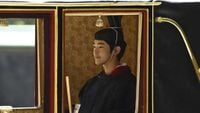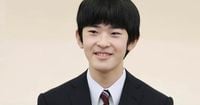Japan’s Imperial Family marked a historic milestone this weekend as Prince Hisahito, the only son of Crown Prince Akishino and Crown Princess Kiko, celebrated his formal entry into adulthood on Saturday, September 6, 2025. The elaborate palace rituals—steeped in centuries-old tradition—were not just a rite of passage for the young prince, but a poignant reminder of the precarious future facing the world’s oldest monarchy. With Hisahito now 19, he is the first male royal in four decades to reach adulthood, and, as many observers worry, possibly the last.
Hisahito, born September 6, 2006, is a first-year biology student at Tsukuba University near Tokyo. He’s known for his passion for insects—especially dragonflies. In fact, he has co-authored an academic paper surveying dragonflies on the grounds of his Akasaka estate, a detail that has charmed many in Japan and set him apart from the often aloof image of royalty. At his debut news conference in March, Hisahito said he hopes to focus his studies on “dragonflies and other insects, including ways to protect bug populations in urban areas.”
Yet, beneath the celebrations, the Imperial Family faces an existential dilemma. With just 16 adult members and only three male heirs—including Hisahito’s 89-year-old great-uncle Prince Hitachi—the line of succession is perilously thin. Hisahito is second in line to the Chrysanthemum Throne, after his father, and the nephew of Emperor Naruhito, who has only one child, Princess Aiko. Under the current 1947 Imperial House Law, only males can inherit the throne, which means Princess Aiko, despite her popularity and public support, is barred from succession.
Hisahito’s coming-of-age ceremony was the first for a Japanese imperial prince since his father, Crown Prince Akishino, in 1985. The rituals were delayed by a year so the prince could focus on university entrance exams—a nod to the pressures facing modern royal youth. The day began at his family residence, where he received a kanmuri crown from a messenger of the emperor. “Thank you very much for bestowing the crown today at the coming-of-age ceremony,” Hisahito said, as reported by The Guardian. “I will fulfil my duties, being aware of my responsibilities as an adult member of the imperial family.”
At the Imperial Palace, Hisahito donned traditional beige robes symbolizing youth, which were replaced by the black kanmuri headpiece marking his new adult status. He bowed deeply to Emperor Naruhito, thanked his parents for their support, and pledged to “fulfil his responsibility as a royal member.” Afterward, he changed into formal attire and rode in a royal horse-drawn carriage to the palace’s three shrines, where he offered prayers for the nation. The ceremonies will continue in the coming days with visits to Ise Shrine—the most sacred Shinto site—along with the mausoleum of Emperor Jinmu, Japan’s mythical first emperor, and the grave of his great-grandfather, wartime Emperor Hirohito. He is also scheduled to meet Prime Minister Shigeru Ishiba and other dignitaries.
Hisahito’s family, including his two older sisters—Princess Kako and former Princess Mako—gathered for a private celebration at a Tokyo hotel. Mako, once a popular royal, gave up her title upon marrying a commoner, a requirement under current law that underscores the challenges facing female members of the Imperial Family. As AP noted, the 1947 law not only restricts succession to males but also forces princesses to relinquish their royal status if they marry outside the aristocracy.
The shortage of male successors is a serious concern for the monarchy, which historians say has lasted for 1,500 years. Japan has had eight female emperors in its history—the last being Empress Gosakuramachi in the 18th century—but female succession was banned by an 1889 law and reaffirmed by the 1947 Imperial House Law. Experts argue that the male-only system is “structurally flawed,” as it once relied on concubines to ensure a steady supply of male heirs, a practice long abandoned.
Former Imperial Household Agency chief Shingo Haketa captured the gravity of the situation, telling Associated Press, “The fundamental question is not whether to allow male or female succession line but how to save the monarchy.” Public opinion polls consistently show strong support for allowing Princess Aiko and other women to ascend the throne, but conservative factions have resisted reform. In 2005, the government considered a proposal to allow a female emperor, but Hisahito’s birth shifted the political winds and nationalists rallied against the change.
More recently, a conservative panel in January 2022 recommended maintaining male-line succession while allowing female royals to retain their status after marriage and continue official duties. Another suggestion has been to adopt male descendants from now-defunct distant royal branches, but the debate has stalled, particularly over whether to grant royal status to non-royals who marry princesses and their children. The conservative newspaper Yomiuri called in May for an urgent revision to the Imperial House Law, urging parliament to “responsibly reach a conclusion on the crisis surrounding the state and the symbol of the unity of the people.”
With the monarchy’s future uncertain, the burden of tradition rests heavily on Hisahito’s young shoulders. For now, he seems determined to carve his own path, balancing his royal responsibilities with his academic pursuits and love of insects. But as AP and Nippon both observed, the question of succession looms larger than ever. The coming-of-age of Prince Hisahito has reignited a national conversation about gender, tradition, and the viability of the imperial institution in modern Japan.
As the rituals unfold and the public watches with a mixture of pride and anxiety, one thing is clear: the fate of the world’s oldest monarchy may depend on choices made in the coming years—choices that will determine whether Hisahito is remembered as a bridge to the future or the last of his line.





